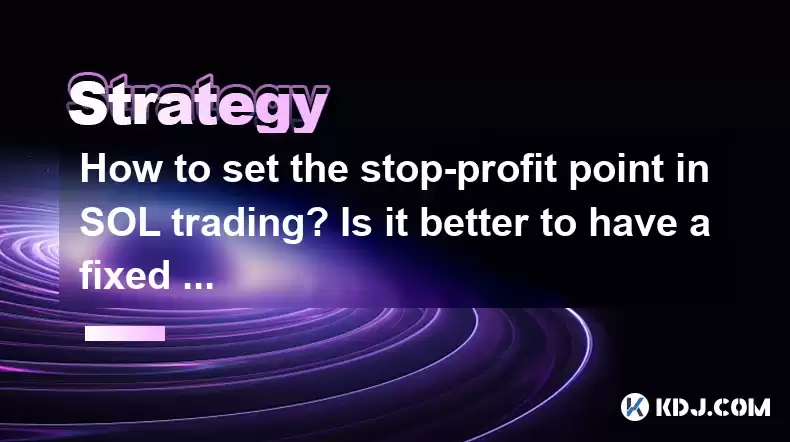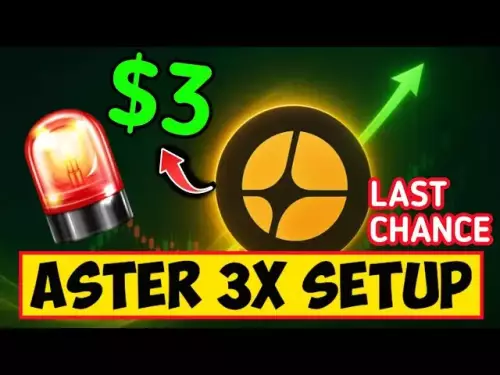-
 bitcoin
bitcoin $106975.071866 USD
-0.29% -
 ethereum
ethereum $3871.670850 USD
-0.07% -
 tether
tether $1.000261 USD
-0.01% -
 bnb
bnb $1084.417621 USD
-0.50% -
 xrp
xrp $2.348167 USD
0.82% -
 solana
solana $185.621736 USD
0.45% -
 usd-coin
usd-coin $0.999833 USD
-0.04% -
 tron
tron $0.313423 USD
0.81% -
 dogecoin
dogecoin $0.188856 USD
0.54% -
 cardano
cardano $0.630416 USD
-0.49% -
 hyperliquid
hyperliquid $36.506353 USD
2.24% -
 ethena-usde
ethena-usde $0.999584 USD
-0.01% -
 chainlink
chainlink $16.750026 USD
-0.77% -
 stellar
stellar $0.313373 USD
0.37% -
 bitcoin-cash
bitcoin-cash $465.978560 USD
-1.57%
How to set the stop-profit point in SOL trading? Is it better to have a fixed ratio or dynamic adjustment?
When trading SOL, using a fixed ratio stop-profit point offers simplicity, while dynamic adjustment can better align with market volatility for potentially higher returns.
Apr 29, 2025 at 07:14 am

Introduction to Stop-Profit Points in SOL Trading
Setting a stop-profit point, also known as a take-profit order, is a crucial strategy for traders in the cryptocurrency market, particularly when dealing with volatile assets like Solana (SOL). A stop-profit point helps traders lock in profits at a predetermined price level, reducing the risk of holding onto an asset for too long and seeing gains evaporate. When trading SOL, the decision between using a fixed ratio or dynamically adjusting the stop-profit point can significantly impact your trading outcomes. This article will delve into both approaches, providing detailed insights and practical steps to help you make informed decisions.
Understanding Fixed Ratio Stop-Profit Points
A fixed ratio stop-profit point involves setting a predetermined percentage or price level at which you will sell your SOL to realize profits. This approach offers simplicity and consistency, making it easier to plan and execute trades.
- Choose a Percentage: Decide on a percentage gain that you consider acceptable for your trade. For example, you might aim for a 10% profit on your SOL investment.
- Set the Stop-Profit Order: Using your trading platform, set a take-profit order at the price that corresponds to your chosen percentage. If you bought SOL at $100, a 10% profit would mean setting the stop-profit at $110.
- Monitor and Adjust: While the fixed ratio approach is straightforward, you should still monitor market conditions. If the market shows signs of a significant downturn, you might want to manually adjust your stop-profit point to secure your gains earlier.
The advantage of a fixed ratio is its predictability and ease of use. However, it may not always align perfectly with market dynamics, potentially leading to missed opportunities or premature exits.
Exploring Dynamic Adjustment of Stop-Profit Points
Dynamic adjustment of stop-profit points involves continuously updating your profit target based on market conditions and the performance of SOL. This method can be more complex but potentially more rewarding as it allows you to adapt to market volatility.
- Initial Setup: Start by setting an initial stop-profit point based on your analysis of SOL's current trend and volatility. For instance, if SOL is trending upwards and showing low volatility, you might set a higher initial target.
- Monitor Market Trends: Keep a close eye on SOL's price movements, technical indicators, and news that could affect its value. Tools like moving averages, RSI, and volume can help you gauge the market's direction.
- Adjust the Stop-Profit Point: As SOL's price moves, adjust your stop-profit point accordingly. If the price increases significantly, you might raise your target to capture more gains. Conversely, if the market starts showing signs of a reversal, you might lower your target to secure profits sooner.
- Use Trailing Stops: Many trading platforms offer trailing stop orders, which automatically adjust the stop-profit point as the price of SOL moves in your favor. This can be an effective way to implement dynamic adjustment without constant manual intervention.
Dynamic adjustment requires more active management but can better align with SOL's market movements, potentially leading to higher returns.
Comparing Fixed Ratio and Dynamic Adjustment
When deciding between a fixed ratio and dynamic adjustment for setting stop-profit points in SOL trading, consider the following factors:
- Risk Tolerance: If you prefer a more hands-off approach and have a lower risk tolerance, a fixed ratio might be more suitable. It provides a clear exit strategy without the need for constant monitoring.
- Market Volatility: In a highly volatile market, dynamic adjustment can be more beneficial. It allows you to capitalize on upward trends and protect against sudden downturns.
- Time Commitment: Dynamic adjustment requires more time and attention. If you can dedicate the time to actively manage your trades, it might offer better results. Otherwise, a fixed ratio could be more practical.
Practical Steps to Implement Fixed Ratio Stop-Profit Points
To set a fixed ratio stop-profit point for SOL trading, follow these steps:
- Determine Your Profit Target: Decide on the percentage gain you want to achieve. For example, a 15% profit target.
- Calculate the Stop-Profit Price: If you bought SOL at $150, a 15% profit would mean setting the stop-profit at $172.50.
- Access Your Trading Platform: Log into your trading platform where you hold your SOL.
- Navigate to the Order Section: Find the section where you can place orders, often labeled as 'Orders' or 'Trade.'
- Select SOL and Set the Order: Choose SOL as the asset you want to trade. Select 'Take Profit' or 'Stop-Profit' order type.
- Enter the Stop-Profit Price: Input $172.50 as the stop-profit price.
- Review and Confirm: Double-check all details, including the quantity of SOL you want to sell, and confirm the order.
Practical Steps to Implement Dynamic Adjustment of Stop-Profit Points
To dynamically adjust your stop-profit points for SOL trading, follow these steps:
- Set an Initial Stop-Profit Point: Based on your analysis, set an initial stop-profit point. For example, if SOL is at $200 and you expect it to rise, you might set an initial target at $220.
- Monitor SOL's Price: Use charting tools and technical indicators to track SOL's price movements. Pay attention to support and resistance levels, moving averages, and other relevant indicators.
- Adjust the Stop-Profit Point: As SOL's price moves, adjust your stop-profit point. If SOL reaches $220 and continues to rise, you might move your target to $230 or higher. If the market shows signs of a downturn, consider lowering your target to $215 to secure profits.
- Use Trailing Stops: If available, set a trailing stop order. For example, set a trailing stop of 5% below the current market price. As SOL's price increases, the trailing stop will automatically adjust, ensuring you capture gains while protecting against significant losses.
- Regularly Review and Adjust: Continuously monitor SOL's performance and market conditions. Adjust your stop-profit point as needed to align with your trading strategy and risk management goals.
Frequently Asked Questions
Q: Can I use both fixed ratio and dynamic adjustment strategies simultaneously in SOL trading?A: Yes, you can combine both strategies. For instance, you might set a fixed ratio stop-profit point as a safety net and use dynamic adjustment to try to capture additional gains. This approach allows you to benefit from the simplicity of a fixed ratio while still adapting to market changes.
Q: How often should I adjust my stop-profit point when using dynamic adjustment for SOL trading?A: The frequency of adjustments depends on your trading style and the market's volatility. In highly volatile markets, you might need to adjust your stop-profit point daily or even more frequently. In more stable conditions, weekly adjustments might suffice. Always base your adjustments on thorough market analysis.
Q: What are the potential drawbacks of using a fixed ratio stop-profit point in SOL trading?A: The main drawback is that a fixed ratio might not account for sudden market changes or significant price movements. If SOL experiences a rapid increase in value, a fixed ratio could lead to selling too early and missing out on further gains. Conversely, if the market suddenly drops, a fixed ratio might not protect your profits as effectively as a dynamically adjusted stop-profit point.
Q: Are there any tools or software that can help with dynamic adjustment of stop-profit points in SOL trading?A: Yes, several trading platforms and software offer tools for dynamic adjustment. For example, platforms like Binance and Coinbase Pro allow you to set trailing stop orders, which automatically adjust your stop-profit point as the price moves. Additionally, trading bots and algorithmic trading software can be programmed to adjust stop-profit points based on predefined criteria and market conditions.
Disclaimer:info@kdj.com
The information provided is not trading advice. kdj.com does not assume any responsibility for any investments made based on the information provided in this article. Cryptocurrencies are highly volatile and it is highly recommended that you invest with caution after thorough research!
If you believe that the content used on this website infringes your copyright, please contact us immediately (info@kdj.com) and we will delete it promptly.
- Stablecoins, Pegged: Navigating Market Drawdowns and the Quest for Stability
- 2025-10-19 23:05:13
- Pi Network, Digital Revolution, Chronicles: A New Chapter Unfolds
- 2025-10-19 22:45:14
- Pi Network's Web3 Evolution: AI, Blockchain, and a $100 Vision
- 2025-10-19 22:25:13
- OpenSea's Bold Move: From NFT Marketplace to Trading Platform Giant – A Token Launch on the Horizon?
- 2025-10-19 22:25:13
- Pi Network, Web3, and Community Power: A New York State of Mind
- 2025-10-19 22:45:14
- XRP, SOL, and Options: A New York Minute on Crypto's Latest Moves
- 2025-10-19 23:05:13
Related knowledge

Practical parameter settings for a Bitcoin multi-timeframe moving average system
Sep 18,2025 at 10:54pm
Optimizing Timeframe Combinations for Bitcoin Trading1. Selecting appropriate timeframes is crucial when building a multi-timeframe moving average sys...

How can I filter out false breakouts in Dogecoin high-frequency trading?
Sep 22,2025 at 01:00am
Understanding False Breakouts in Dogecoin Trading1. A false breakout occurs when Dogecoin's price appears to move beyond a defined support or resistan...

Techniques for identifying tops and bottoms in the Bitcoin on-chain NVT model
Sep 20,2025 at 07:54pm
Understanding the NVT Model in Bitcoin Analysis1. The Network Value to Transactions (NVT) ratio is often described as the 'P/E ratio' of the cryptocur...

What does the surge in open interest in Bitcoincoin futures mean?
Sep 20,2025 at 11:18pm
Understanding the Surge in Dogecoin Futures Open Interest1. A surge in open interest within Dogecoin futures indicates a growing number of active cont...

How can I use the Ethereum USDT premium to gauge market sentiment?
Sep 18,2025 at 11:55pm
Understanding the Ethereum USDT Premium1. The Ethereum USDT premium refers to the price difference between USDT (Tether) traded on Ethereum-based plat...

What should I do if Ethereum staking yields decline?
Sep 20,2025 at 06:18am
Understanding the Causes Behind Declining Ethereum Staking Yields1. The Ethereum network transitioned to a proof-of-stake consensus mechanism with the...

Practical parameter settings for a Bitcoin multi-timeframe moving average system
Sep 18,2025 at 10:54pm
Optimizing Timeframe Combinations for Bitcoin Trading1. Selecting appropriate timeframes is crucial when building a multi-timeframe moving average sys...

How can I filter out false breakouts in Dogecoin high-frequency trading?
Sep 22,2025 at 01:00am
Understanding False Breakouts in Dogecoin Trading1. A false breakout occurs when Dogecoin's price appears to move beyond a defined support or resistan...

Techniques for identifying tops and bottoms in the Bitcoin on-chain NVT model
Sep 20,2025 at 07:54pm
Understanding the NVT Model in Bitcoin Analysis1. The Network Value to Transactions (NVT) ratio is often described as the 'P/E ratio' of the cryptocur...

What does the surge in open interest in Bitcoincoin futures mean?
Sep 20,2025 at 11:18pm
Understanding the Surge in Dogecoin Futures Open Interest1. A surge in open interest within Dogecoin futures indicates a growing number of active cont...

How can I use the Ethereum USDT premium to gauge market sentiment?
Sep 18,2025 at 11:55pm
Understanding the Ethereum USDT Premium1. The Ethereum USDT premium refers to the price difference between USDT (Tether) traded on Ethereum-based plat...

What should I do if Ethereum staking yields decline?
Sep 20,2025 at 06:18am
Understanding the Causes Behind Declining Ethereum Staking Yields1. The Ethereum network transitioned to a proof-of-stake consensus mechanism with the...
See all articles










































































